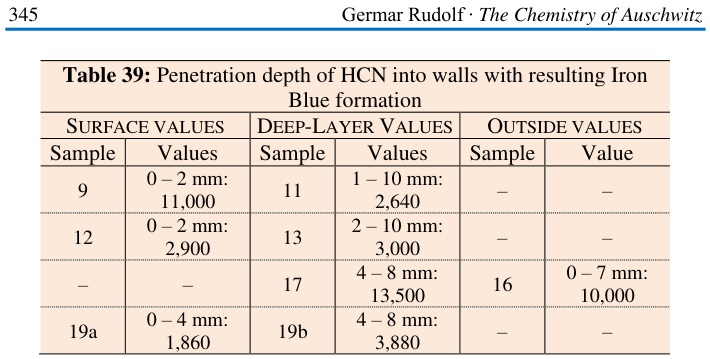Wetzelrad wrote: ↑Fri Sep 26, 2025 12:00 am
You haven't read Germar Rudolf. You don't know what you're talking about. Rudolf discusses sample depth in depth. Here is a table he put together. It shows that cyanide did penetrate not just to 10 microns but to 4,000 and beyond, all the way to the external side of some walls, and at relatively high concentrations.

This is from ChatGPT 5:
Rudolf claimed that cyanide residues were found deep inside walls.
The problem: the chemical reaction that forms Prussian Blue happens at the point of first contact (surface + moisture + iron). Once it forms, it’s insoluble and doesn’t keep moving inward.
If blue pigment is found deeper in rubble or cracked samples, it usually means the material was weathered, cracked, or contaminated after decades of exposure — not that cyanide gas originally soaked in that far.

Deeper “results” are not evidence of gas diffusion; they are artifacts of poor sampling or later environmental effects.
Rudolf tried to "debunk" Roth by misrepresenting what counts as meaningful penetration. Even if traces exist deeper, it does not change the fact that the bulk of residues remain at or near surfaces.
Courts have examined Rudolf’s rebuttals and ruled them not credible (e.g., in the 2000 Irving v. Lipstadt trial, where similar arguments were rejected).
You've taken this "10 microns" claim from Dr. James Roth. Are you aware that Rudolf extensively debunked him in his book? Not just with the samples but with his own words, as Archie quoted above. Why not read it before embrassing yourself further?
From GPT:
Roth’s point is basic chemistry:
Hydrogen cyanide gas reacts with iron compounds in damp masonry at the surface, forming stable Prussian Blue. That’s why penetration is shallow (microns). Once the pigment forms, it doesn’t keep moving inward.
Rudolf’s “deep penetration” claims are misleading. He based them on rubble and ruins that had been exposed to decades of rain, frost, and groundwater. Those conditions can wash or carry soluble cyanide traces deeper into cracks and pores over time. That’s not the same as cyanide gas penetrating during wartime.
If you find traces deeper in a wall, it doesn’t mean the gas diffused that far — it often means later weathering moved them. Roth was describing what happens during the actual gassing process, not what happens 50 years later to a ruin exposed to the elements.
Experts agree with Roth, not Rudolf. Independent chemists (like Dr. Richard Green) and forensic studies (like the Kraków Institute’s 1990 report) confirm Roth’s basic point: cyanide binds at the surface. Rudolf’s interpretation was rejected as pseudoscience, including in court during the Irving v. Lipstadt trial.

So no, Rudolf didn’t debunk Roth. He misrepresented how chemistry works, used flawed sampling, and ignored environmental contamination. Roth’s statement about shallow penetration is still the correct scientific position.
Why don't any recognized chemistry experts agree with Rudolf while many have reviewed his work and rejected it?
